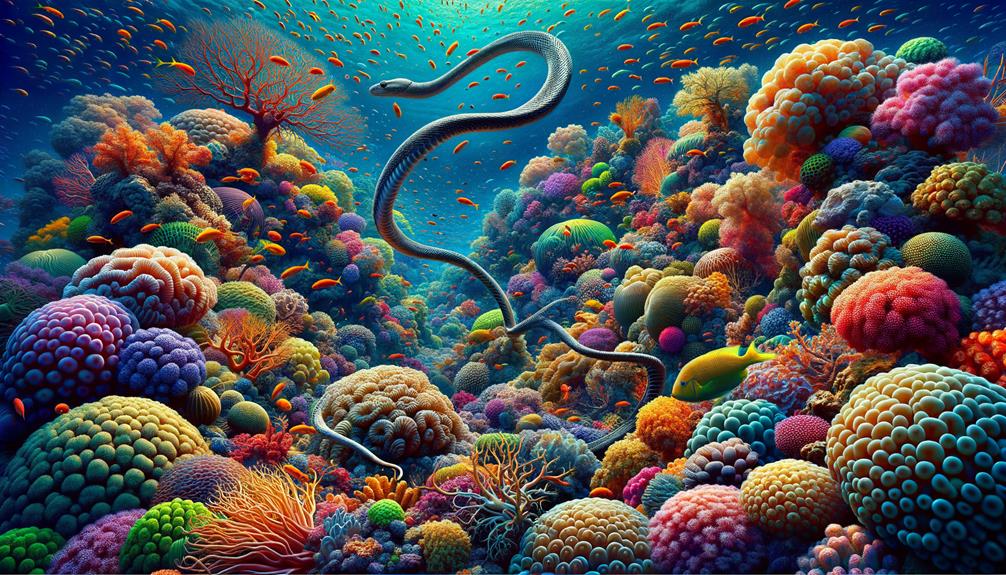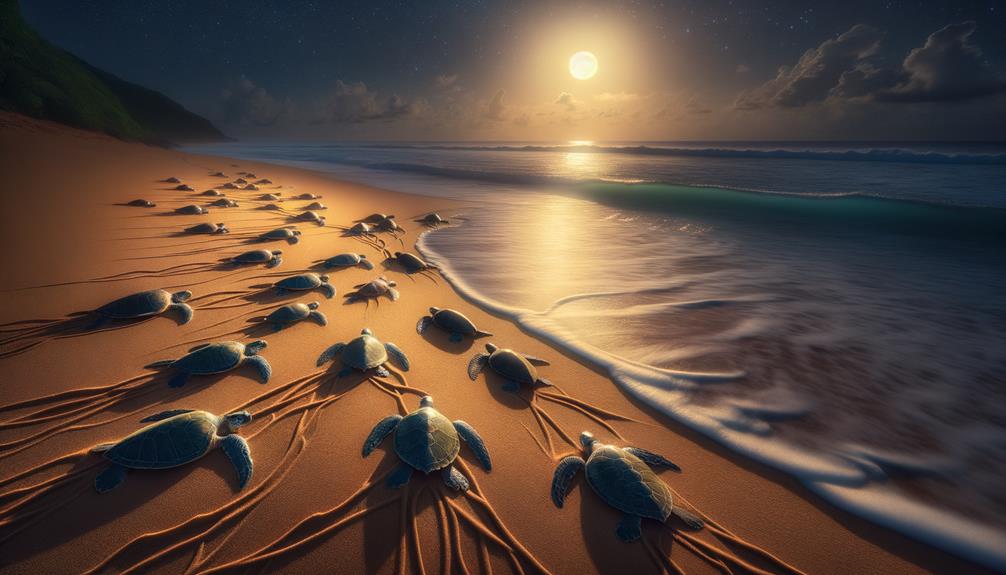Strolling along the jagged coastline of the Galapagos, I found myself drawn to the marine iguanas lounging on sun-warmed rocks. These remarkable reptiles, sporting rough, dark scales with occasional splashes of red and green, have perfectly adapted to their seaside environment. I watched in awe as they effortlessly plunged into the ocean, showcasing their unique ability to graze on underwater algae and expel excess salt through specialized glands. As I continued to observe these ancient creatures, I began to ponder what other fascinating characteristics and behaviors they might possess. The more time I spent studying them, the more questions arose about their incredible adaptations and survival strategies in this harsh yet beautiful ecosystem.
Habitat and Distribution
Marine iguanas are a common sight across the Galapagos Islands, adapting to various coastal environments from craggy shores to tidal flats. During my travels through the archipelago, I couldn't help but notice their resilience and widespread presence. These creatures can be spotted on nearly every coastline, soaking up the sun or plunging into the sea for their algae meals.
The iguanas have spread impressively throughout the Galapagos. From Fernandina's rough, wave-beaten cliffs to Santa Cruz's calm, sunny beaches, they've found homes in diverse seaside settings. Each island seems to host a distinct population, with Española Island featuring the striking red-and-green Christmas Iguanas—a fascinating example of possible subspecies adaptation.
These reptiles have shown remarkable versatility in their habitat choices. They've mastered survival in settings ranging from stark, volcanic coasts to more protected, sandy shores. Watching them in their natural environments shows how well they've integrated into the Galapagos' coastal ecosystems. Their broad distribution speaks to their toughness and ability to flourish in this unique and demanding landscape.
Physical Characteristics
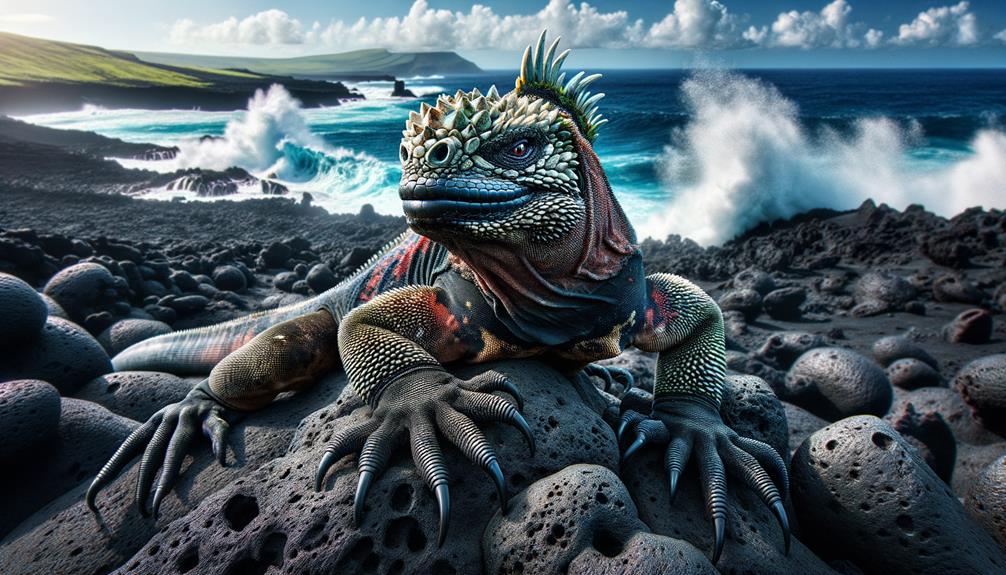
Watching marine iguanas on the Galapagos shores, you can't help but notice their remarkable body features. Their dark skin, splashed with bright green, orange, grey, and yellow spots, serves a dual purpose. It helps them blend in with their surroundings and puts on quite a show during mating season. What's really cool, though, are their flattened tails and special glands that pump out salt. These adaptations are key to their success in the tough ocean environment, letting them swim efficiently and munch on seaweed without getting too salty.
Unique Body Adaptations
Marine iguanas of the Galapagos sport a striking mix of colors – black bodies with splashes of green, orange, grey, and yellow. These hues shift across different islands and become more vivid during mating season. These unique reptiles have developed remarkable traits that make them exceptional swimmers and efficient feeders.
Their flat tails serve as natural rudders, helping them glide through water with surprising grace. This tail design allows them to plunge up to twelve meters deep, where they munch on algae clinging to rocks. They can hold their breath for nearly an hour, effortlessly navigating shallow waters and exposed seaweed areas.
One of their most intriguing features is their ability to expel excess salt through specialized glands near their nostrils. This adaptation is crucial for marine iguanas, as their seaweed diet means they ingest large amounts of saltwater. By shedding this extra salt, they maintain the delicate balance needed to survive in their challenging coastal environment.
These evolutionary adaptations highlight the marine iguanas' incredible journey, showing how they've uniquely fitted themselves to life on the Galapagos coasts. Every dive and tail flick demonstrates nature's inventiveness and the raw beauty of wild existence.
Coloration and Camouflage
The marine iguana's striking appearance isn't just for show – it's a crucial survival tool. These creatures sport a mix of black, green, orange, grey, and yellow hues that help them blend into their rocky coastal homes. This natural camouflage keeps them safe from predators and allows them to move about unnoticed.
Come mating season, their colors become even more vivid, helping them catch the eye of potential partners. Interestingly, marine iguanas on different Galapagos islands have developed distinct color patterns, showcasing evolution's adaptability.
These unique color combinations serve another purpose beyond camouflage. They act as a kind of natural ID system, allowing iguanas to recognize each other. This feature also aids researchers in tracking individual animals.
The marine iguana's color-changing ability is just one of its fascinating traits. Their swimming skills and specialized salt-expelling glands are equally impressive adaptations to their coastal lifestyle. These reptiles have truly mastered the art of survival in their challenging environment.
Unique Adaptations
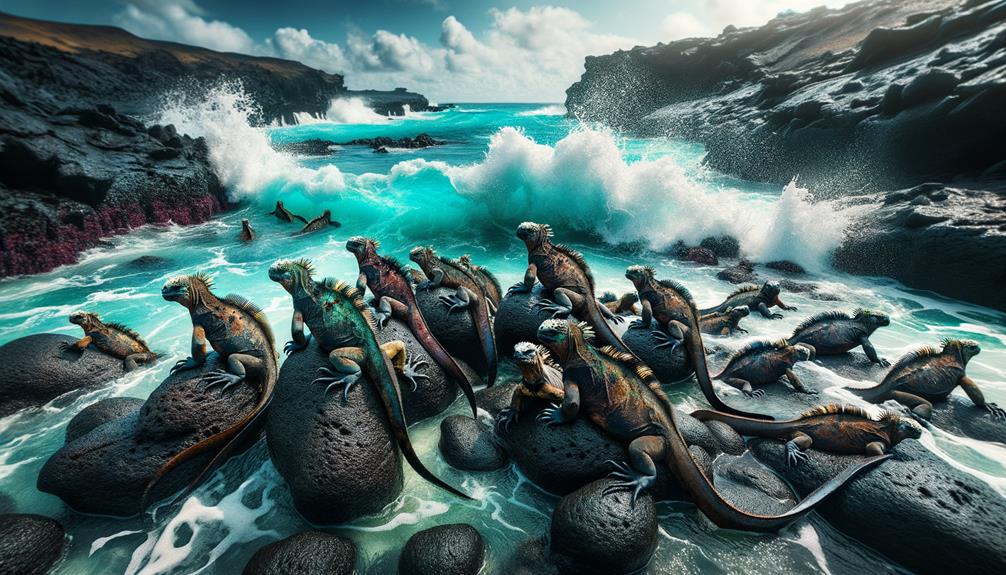
Marine iguanas in the Galapagos have developed remarkable ways to thrive in their challenging ocean environment. These unique creatures have special salt glands near their noses that push out excess salt, allowing them to swim in seawater without getting dehydrated.
Their flat tails are perfectly suited for swimming and maneuvering through ocean currents. This adaptation is crucial for their survival, as it lets them dive for algae, their main food source. These iguanas can hold their breath for up to half an hour while underwater, showing their impressive stamina.
After cold dips in the ocean, marine iguanas warm up by basking in the sun, a vital part of managing their body temperature. This behavior highlights how well they've adapted to their distinctive lifestyle. Watching these animals in their natural habitat, you can't help but be impressed by their evolutionary adaptations, which showcase nature's incredible creativity.
Feeding Habits
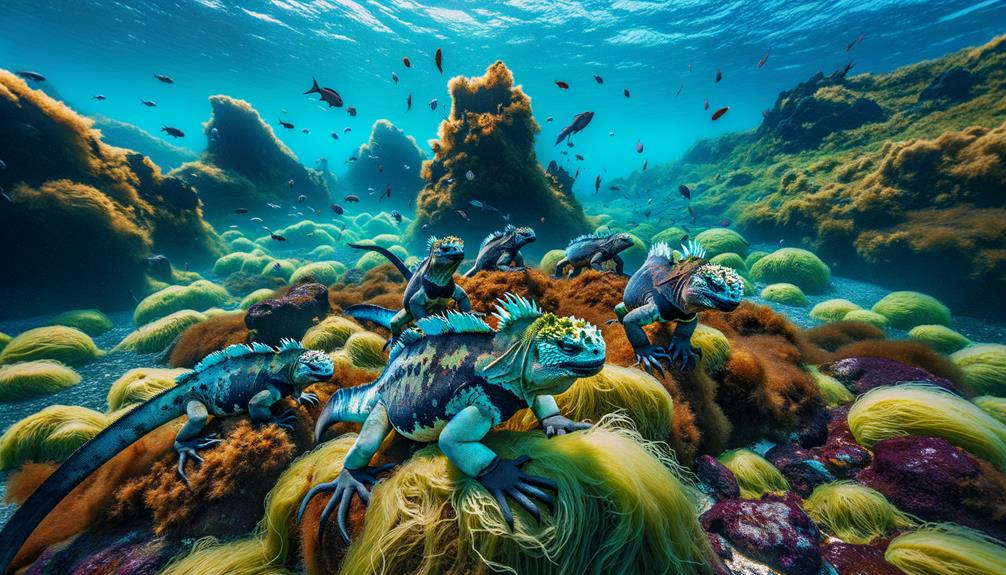
Marine iguanas in the Galapagos have developed some pretty cool eating habits. They mostly chow down on algae, which they find underwater near the shore. Their flat tails help them swim smoothly, making it easier to grab their underwater snacks.
These lizards are smart cookies – they prefer to eat seaweed that's exposed, so they don't have to dive too deep or mess with their body heat. They're like surfers who know just when to catch the perfect wave, timing their meals with low tides when the algae is easy to reach. They go for the green, red, and sometimes blue seaweeds, but they're not fans of the brown stuff.
Here's a neat trick: they've figured out how to get rid of extra salt by sneezing it out. This clever move helps them stay healthy in the salty Galapagos environment. The way these critters eat shows how well they've adapted to their surroundings, fitting right into nature's big picture.
Reproduction and Lifecycle
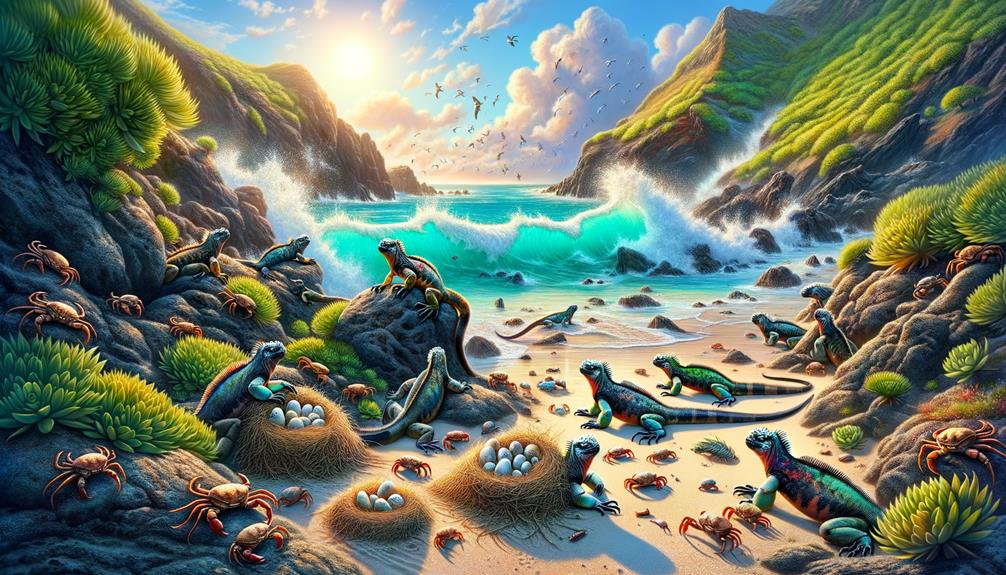
During November and December, marine iguanas in the Galapagos put on quite a show. Males, sporting bright colors, vie for prime spots and female attention along the shore. They bob their heads and flaunt their crests in an eye-catching display.
Females, who become ready to mate at about eight years old, choose their partners carefully. After mating, they dig holes in the sand to lay one to four eggs. These nests, often found in areas washed by the tides, offer a protected, warm spot for the eggs to grow.
The iguana life cycle unfolds like this:
| Stage | What Happens | When |
|---|---|---|
| Ready to Mate | Iguanas reach this stage at about eight | Ongoing |
| Mating Time | Courtship and pairing up happens on the beach | November to December |
| Egg-Laying | Females deposit one to four eggs in sand nests | Right after mating |
The eggs take three to four months to hatch. Then, the tiny iguanas face a tough road to adulthood. They munch on algae in the tidal areas of the islands, battling many obstacles. These young creatures show how nature designs animals to adapt and thrive in challenging environments.
Conservation Efforts
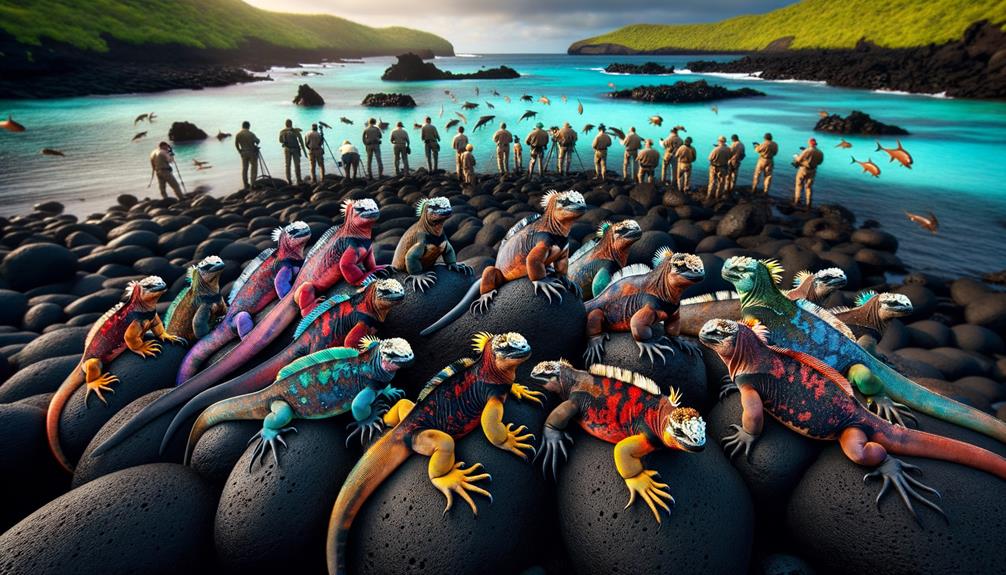
The Galapagos Islands' one-of-a-kind ecosystem faces big challenges, but dedicated efforts are underway to protect the future of its remarkable marine iguanas. These ancient reptiles, shielded by Ecuadorian law and listed on CITES Appendix II, play a key role in the islands' natural balance. Despite protection, dangers like invasive cats and dogs, El Niño weather patterns, oil spills, and plastic waste continue to put their survival at risk.
Conservationists are working hard to counter these threats in various ways. They're running ongoing studies to track population changes and assess the impact of plastic pollution. By grasping these factors, we can put targeted plans into action to safeguard marine iguanas. For example, getting rid of invasive species and setting up clean zones are crucial steps.
Tourists play a big part in supporting these protection efforts. Their donations, purchases of special Galapagos pin badges, and hands-on involvement in conservation programs provide much-needed funding and raise awareness. Every bit of help counts towards maintaining the fragile ecosystem that marine iguanas call home.
In the end, the survival of marine iguanas depends on our commitment to tackling these threats. Through careful research and community involvement, we can help ensure these iconic creatures continue to thrive on the Galapagos coasts for years to come.
Viewing Tips

To spot marine iguanas, scan rocky shores where they soak up the sun. These reptiles are most active during daylight, especially at low tide when they feed. Grab a pair of binoculars to catch them swimming and foraging underwater – it's quite a sight.
For the best viewing, head to Isabela and Fernandina islands, home to large marine iguana populations. Don't skip Española, Floreana, and Santa Cruz islands though; each offers unique experiences. You'll often see these creatures in social groups, basking and interacting.
Consider joining a tour or hiring a local guide to learn more about marine iguana behavior and ecology. Their expertise can really enrich your visit.
Quick reference for your trip:
| Island | What to Expect |
|---|---|
| Isabela | Big populations, varied landscapes |
| Fernandina | Unspoiled habitats, lively iguanas |
| Española | Bustling colonies, great vistas |
| Floreana | Interesting iguana social behavior |
| Santa Cruz | Convenient access, guided tours available |
Frequently Asked Questions
Why Are Marine Iguanas Only Found in the Galapagos Islands?
Curious about the exclusive presence of marine iguanas in the Galapagos Islands? Their story is a fascinating tale of adaptation and survival. These unique creatures have flourished in isolation, free from mainland threats, and have perfectly adjusted to the islands' volcanic terrain and rich marine plant life. Their evolutionary path, shaped by the Galapagos' distinct environment, has made them a true marvel of nature, found nowhere else on Earth.
What Type of Coast Do Marine Iguanas Live In?
Marine iguanas call the Galapagos' rugged coastline home. These unique creatures bask on sun-warmed rocks and forage in the clear shallows near the shore. You'll spot them clambering over boulders and weaving through patches of seaweed. Their habitat is a striking mix of harsh terrain and vital resources, perfectly suited to their needs. The blend of rocky outcrops and sandy stretches provides these reptiles with everything they require to thrive in this isolated island ecosystem.
How Many Galapagos Marine Iguanas Are Left?
Recent estimates suggest about 300,000 Galapagos marine iguanas remain in the wild. Conservationists keep a close eye on their numbers, with ongoing protection efforts in place. These unique creatures face several challenges, including the impacts of El Niño weather patterns, threats from predators, and the loss of their natural habitats. Scientists and environmental groups continue to work on strategies to safeguard these iconic reptiles, which play a crucial role in the Galapagos ecosystem.
What Is the Status of the Galapagos Marine Iguana?
The Galapagos marine iguana faces ongoing challenges, with its conservation status currently listed as vulnerable. Having observed the effects of El Niño weather patterns and oil spills on these creatures, it's clear that their survival hangs in the balance. Protecting these one-of-a-kind reptiles and their sensitive environments is crucial for their long-term survival. Conservation initiatives play a key role in safeguarding the future of these remarkable animals, unique to the Galapagos archipelago.


